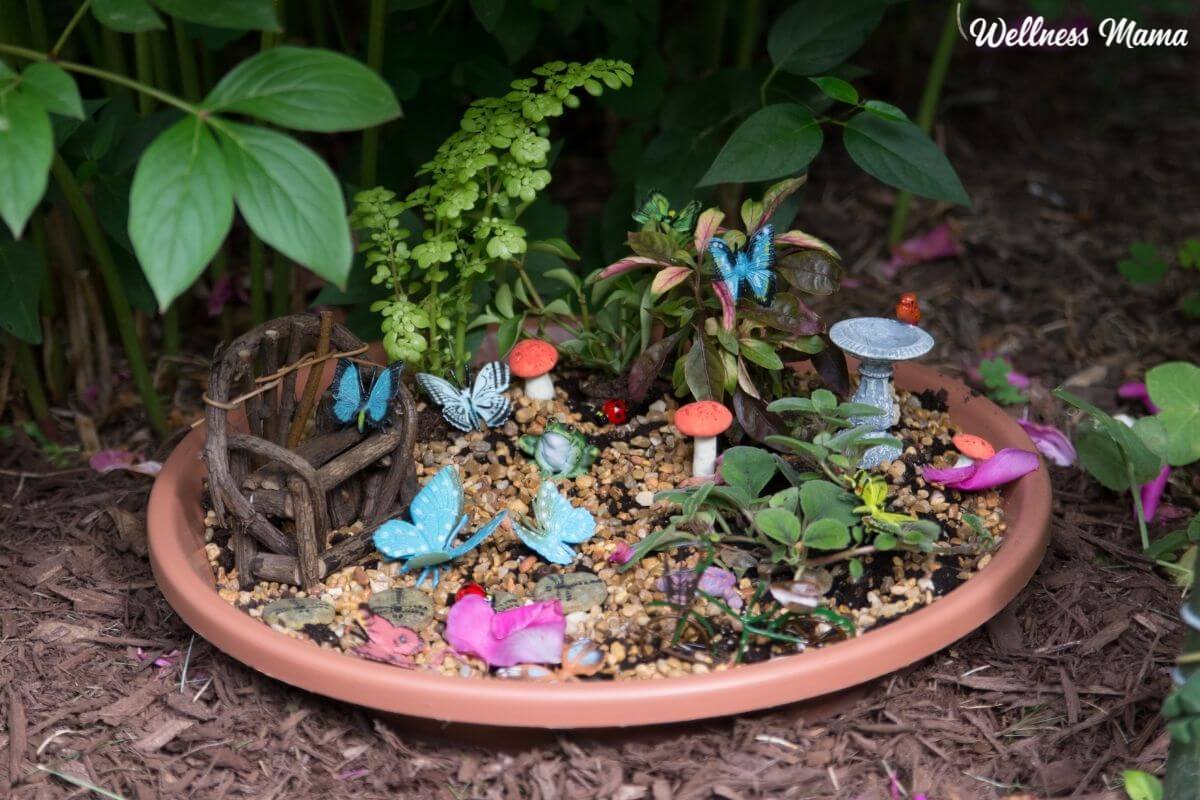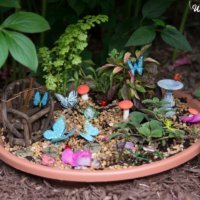There’s something magical about the idea of a fairy garden. It can be just as much fun to plan as a butterfly garden and there are so many possibilities. Here’s how to make a fairy garden in almost any location, with a wide variety of materials.
What Is a Fairy Garden?
No, we’re not growing fairies. A fairy garden is a whimsical way to add a little color and fun to your yard or indoor space. Some plants, fairy figurines, miniature houses, and furniture come together to create the increasingly popular fairy garden. It’s a fun way to get kids involved with gardening and nature and can even make a good gift!
Appealing to Non-Fairy Fans
Not everyone loves fairies or is into that kind of thing, but a “fairy garden” is still a possibility. I can tell you that as a mom of boys they’re more into the backyard forge than they are fairy dust. For older kids or those not into fairies, we can easily tweak some of the props and create a different space.
Try gnomes or little animal figurines instead of fairy ones. The miniature buildings and furniture can be very detailed and are easily a fun afternoon project for kids who love to build. Make a scene from a favorite book or movie using plants and natural materials. Create an alien spaceship or a dinosaur planet. It doesn’t have to be fairies.
What Is the Purpose of a Fairy Garden?
While it is a fun project and appeals to both little ones, big kids, and older folks alike, there’s more to a fairy garden. Yes, it can spark joy, but it can also benefit the ecosystem. An outdoor fairy garden with the right plants can feed pollinators and enrich the soil. If you’re using herbs and medicinal plants, you can have an edible fairy garden. Plus, they just look cool!
How to Make a Fairy Garden for Kids
There are a ton of different options here and it’s best to let your imagination run wild. We do need to establish a few ground rules though to make sure the garden is successful.
Location, Location, Location
Is your fairy garden going to be indoors or outdoors? In the shade under a tree or on the back porch? What plants we choose and how we design the garden depend on where it’s going to be. We don’t want to plant shade loving plants underneath the hot sun on the patio.
Choosing a Container
Another important consideration is the container for the fairy garden. Or think outside the box and plant without a garden container. Just make sure that the plants you want to use will fit your chosen container size. Here are a few ideas:
- Flower pot
- Teacup
- Cake stand (with a round dish on top to contain the dirt)
- Terrarium jar
- Wooden bucket or half barrel
- Metal washtub (the smaller, laundry kind)
- Birdcage (add something to the bottom to contain the dirt)
- Old wagon
- Tree stump
- Upcycled kids water table
- An old drawer, trunk, or suitcase (for inside gardens)
- Birdbath
- Wooden or metal crate
- Old bed frame
Pick Your Plants
Now that we have a container, it’s time to choose the plants. Make sure to choose plants that will fit your chosen container, or vice versa. Succulents, low growing, or smaller plants work best. If you’re planting in a raised bed or on the ground, they can be larger with the fairy furniture nestled in between.
Indoor container fairy gardens need plants that will grow well indoors. Artificial plants are another option. Bark, moss, twigs, and pebbles are good low maintenance indoor options.
Start With Ground Cover
These plants are low growing and spread over larger areas to cover the ground, much like a lawn. It’s nice to start with these as a base, and build up from there. Do a little research to see what will work best in your location and growing zone. Here are some different choices to get you started:
- Irish moss
- Elfin Thyme
- Miniature Oakleaf Creeping Fig
- Golden Creeping Speedwell
- Golden Japanese Stonecrop
- Silver Sprinkles Plant
- Spikemoss
- Dwarf Mondo Grass
- Baby Tears
- Sugar Vine
- Zebra Haworthia
- Corsican Mint
- Chickweed (edible)
- Miniature Daisies
- Cranesbill
- Scotch moss
- Moneywort
- Dusty miller
- Creeping thyme
- Fairy fern
- Miniature ivy
Add Some Height
Succulents, herbs, and small flowers add some variety and contrast to the fairy landscape. Some plants will grow too big for the container and start to crowd out the other plants. In this case keep them pruned down as needed. Here are some good options for your fairy garden:
- Nasturtium (edible)
- Miniature African violet
- Marigolds (good for the butterflies)
- Miniature daisy
- Alyssum
- Globe basil (edible)
- Floss flower
- Impatiens
- Violets (edible)
- Petunias
- Coleus
- Lavender (edible)
Accessorize Your Fairy Garden
This might be my favorite part. There are a lot of fairy garden knickknacks sold online and in stores, but these are just one option. You can use repurposed items from thrift stores or around the house. It’s also fun to make your own or scavenge around outside for pieces from nature.
There are tons of options, but here are a few ideas:
- Mold clay into little garden mushrooms or fairy chairs
- Make wooden ladders with twigs and hot glue
- Use bark for fairy house siding or roof shingles
- Use moss for shingles or pathways
- Make a twig fence
- Use pebbles to create a pathway
- An old wooden spool can become a table
- Glass pebbles make a great “river”
Fairy Garden for Kids
Materials
- container of choice optional
- ground cover plants
- succulents, flowers, and/or small herbs
- nature items bark, pebbles, twigs, etc.
- small rocks
- dirt
- furniture, houses, or other accessories
Instructions
- If you’re making an outdoor fairy garden choose a container with drainage holes in the bottom (or make some holes).
- Add a layer of small rocks, then dirt.
- Arrange the ground cover plants and other plants as desired. Be sure you don’t crowd the area and allow room for growth!
- Add the nature items and accessories as desired to make your own creation.
Notes
What kind of theme would you choose for your fairy garden? Drop us a comment and let us know!



Leave a Reply